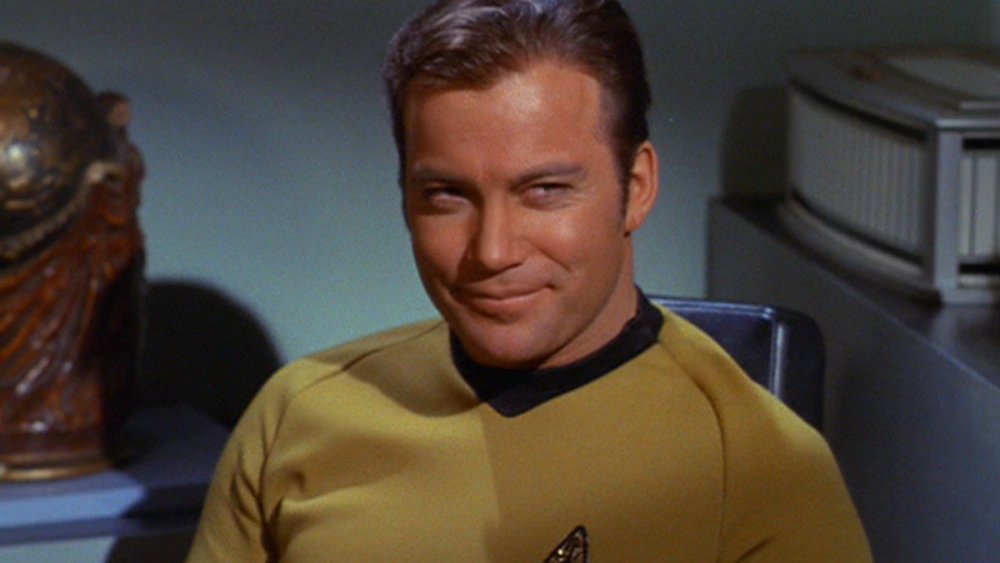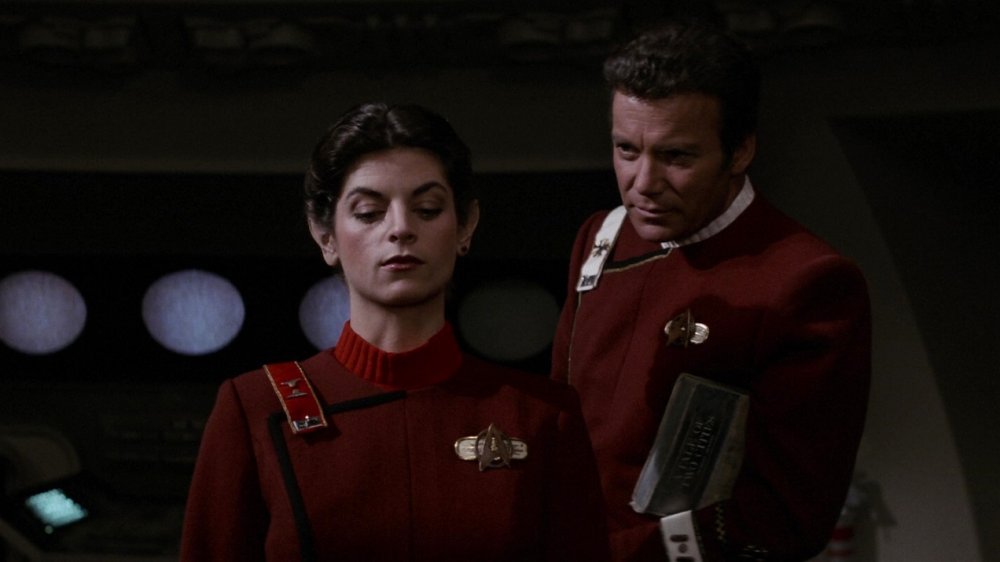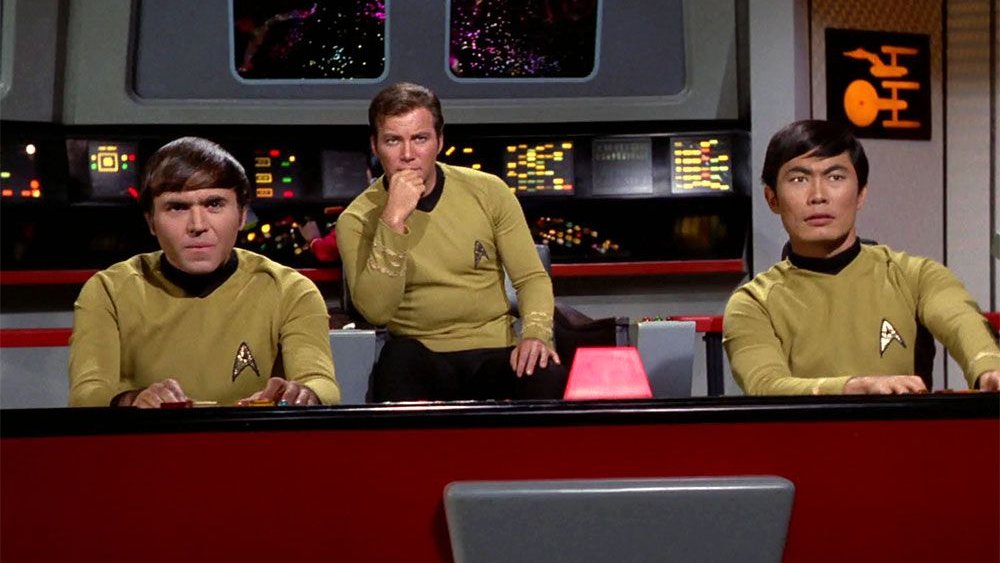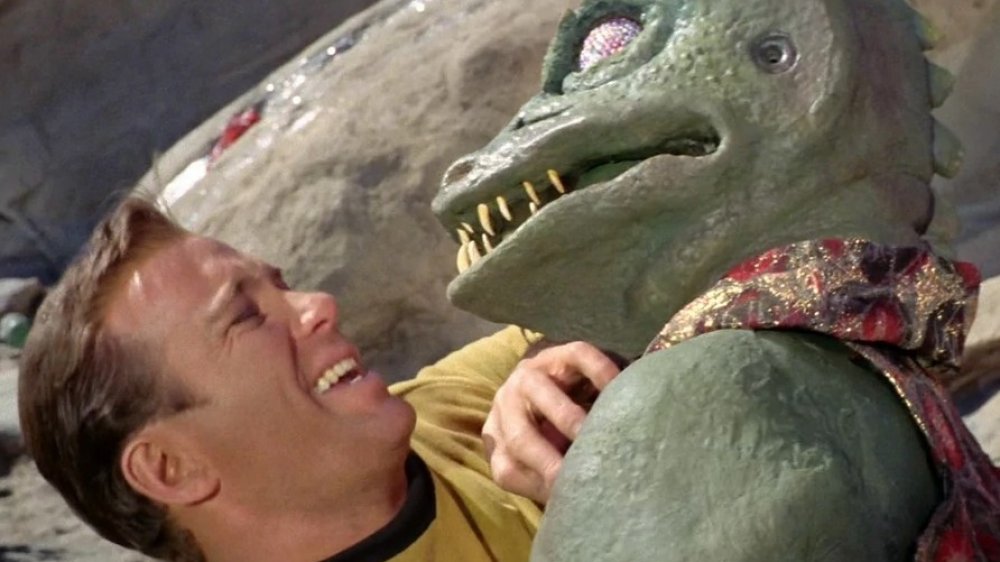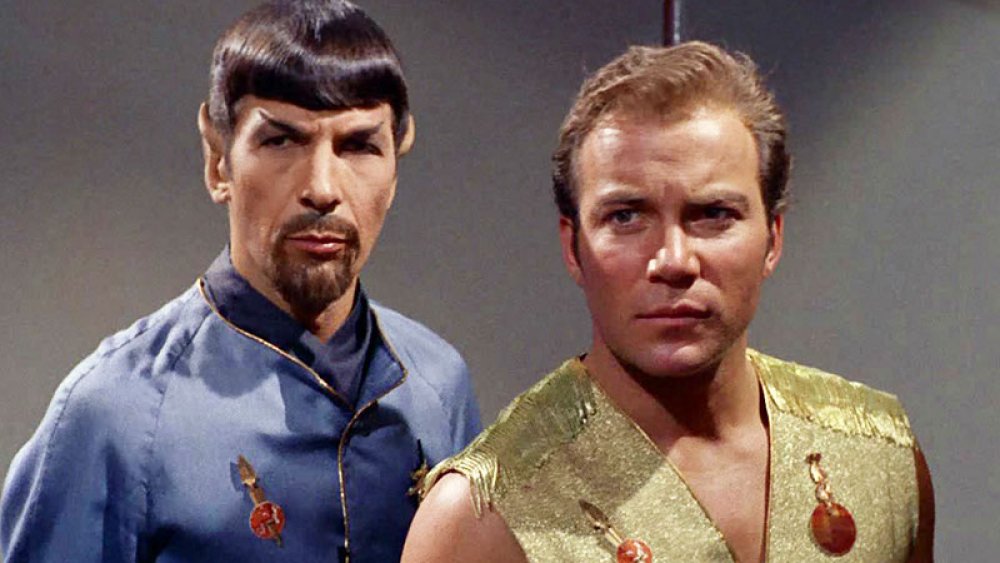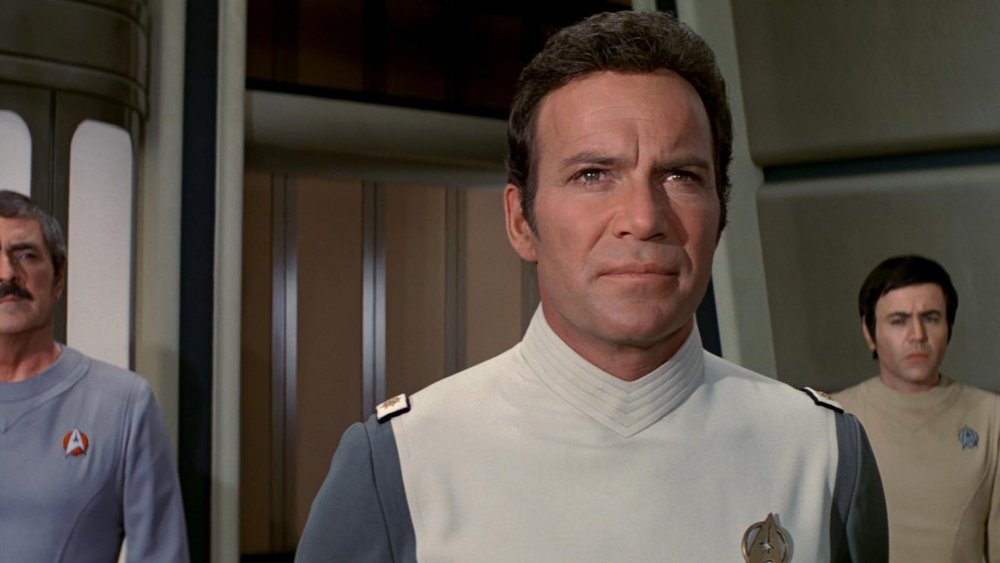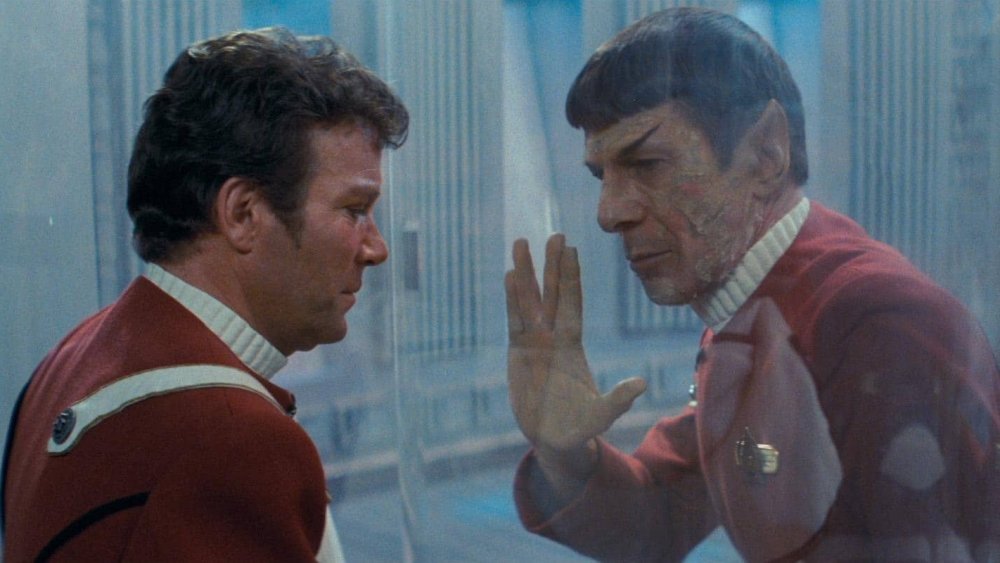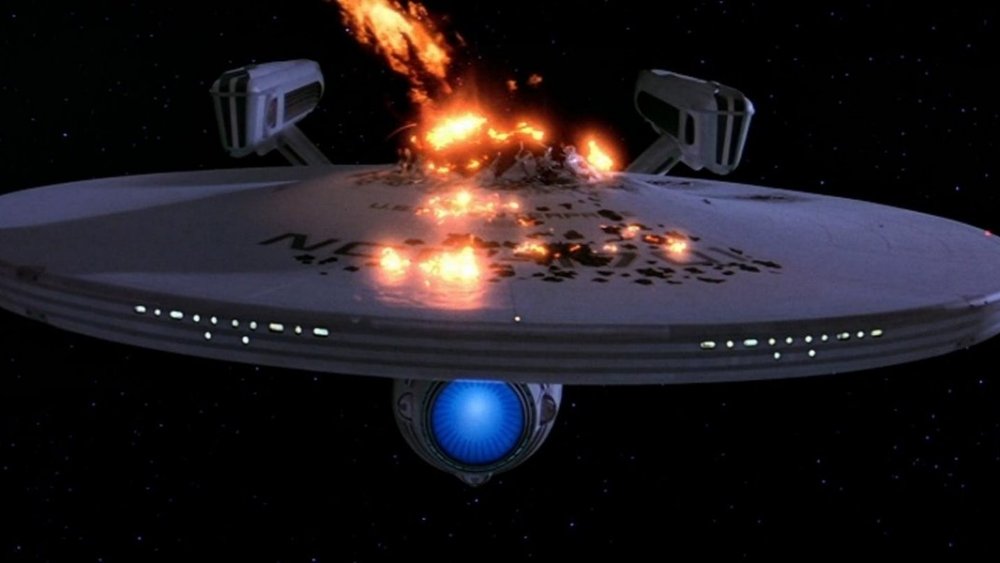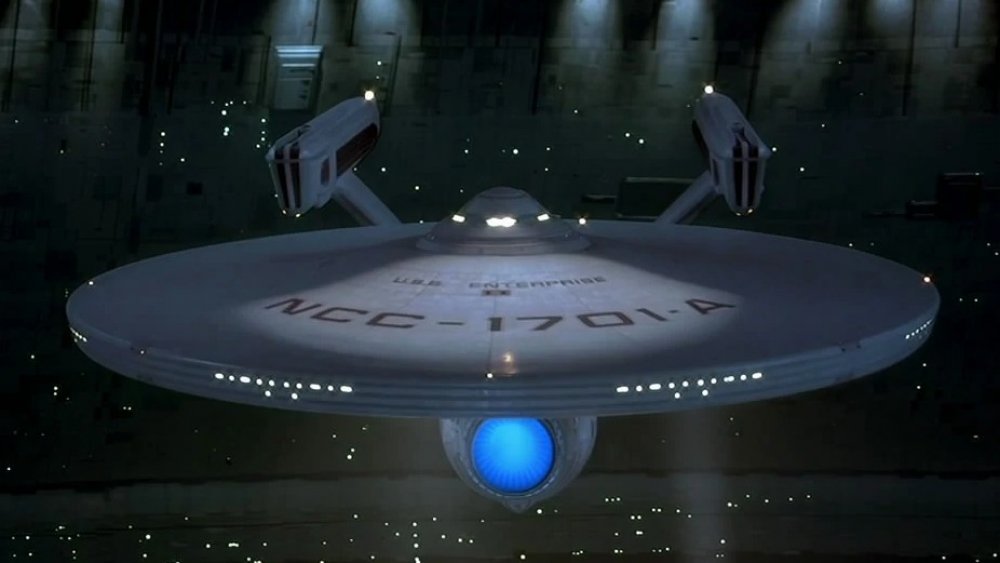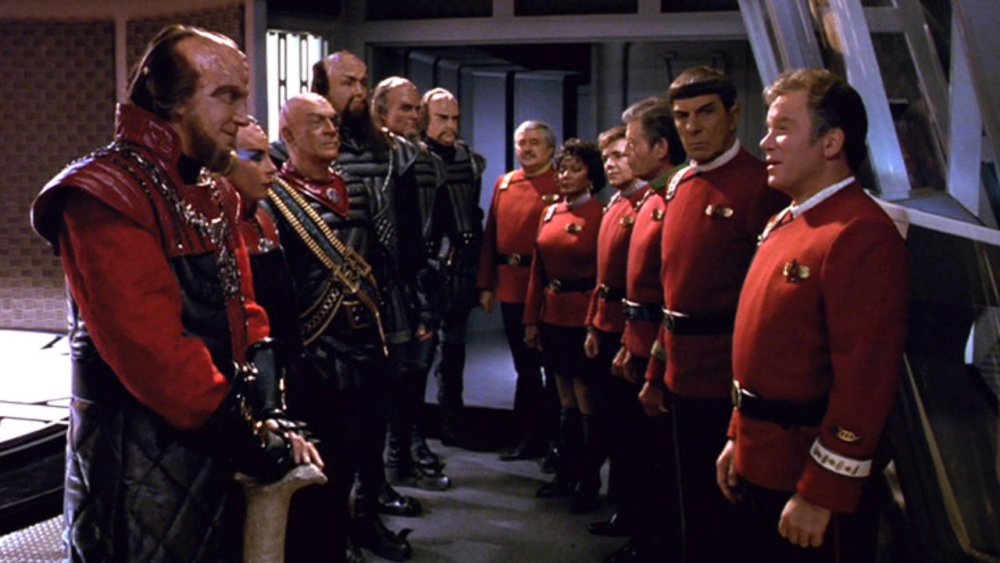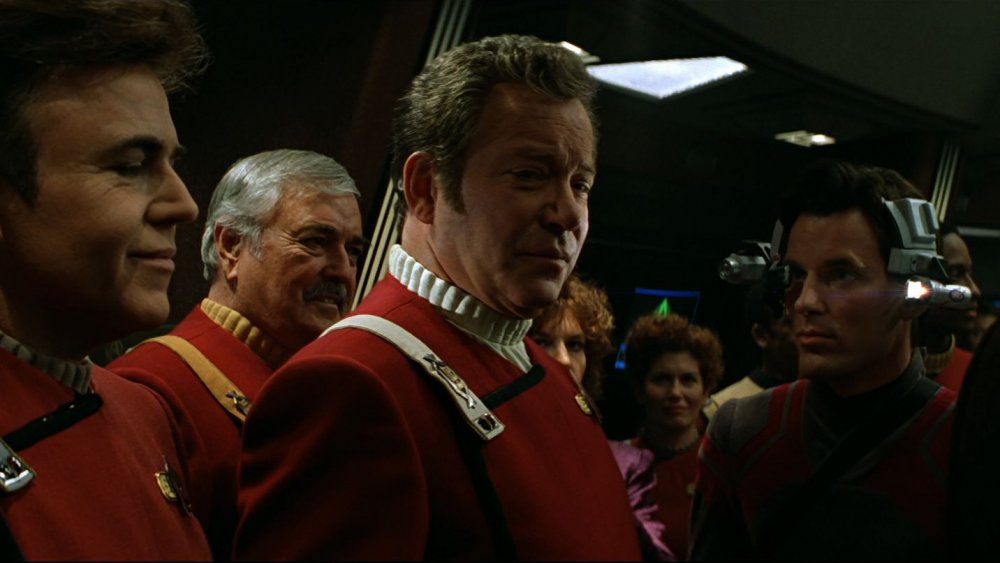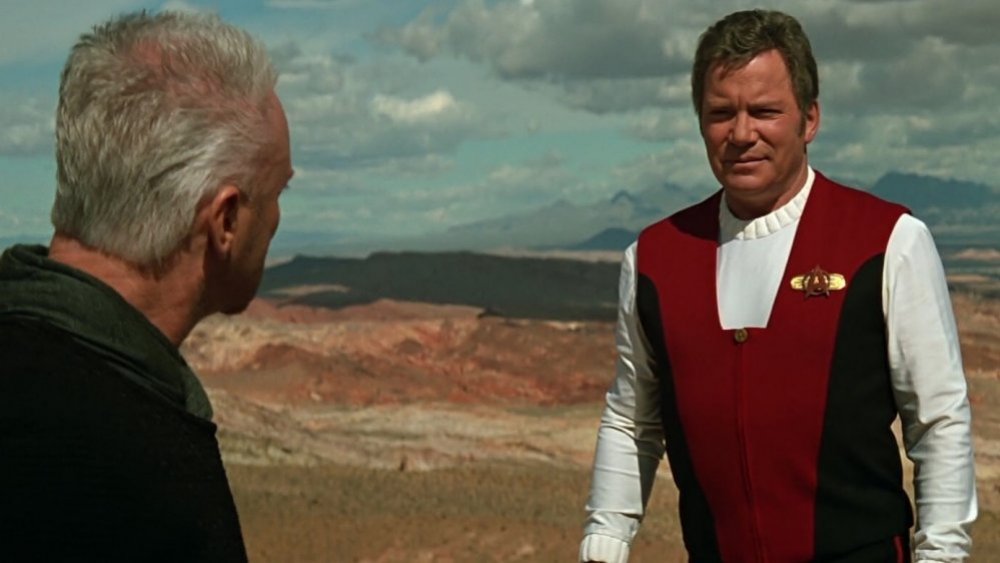Captain Kirk's Entire Backstory Explained
He's the captain against which every other Star Trek captain will always judged — Captain James T. Kirk (William Shatner) of the USS Enterprise. For three seasons of Star Trek: The Original Series (TOS), two seasons of Star Trek: The Animated Series, and seven films, Captain Kirk went where no one had gone before. Even though technically he wasn't the first captain to command Enterprise — Christopher Pike (Jeffrey Hunter) was the ship's captain in the series' pilot — James Kirk will always be seen as the original and, to many fans, the best.
Kirk left a huge mark on the Trek franchise. With the warring voices of Spock (Leonard Nimoy) and Dr. McCoy (DeForest Kelley) guiding him, Kirk's exploration built the foundation for Trek's continuing narrative. He fought wars, he stopped wars, and for better or worse, the distant worlds he visited were forever changed because of his appearance. His legacy will be remembered for as long as the Trek franchise keeps going. If you're curious about how this pioneer lived and died, here's Captain James T. Kirk's entire backstory explained.
Kirk was the only cadet to defeat the Kobayashi Maru
Kirk's Starfleet Academy days are mentioned a few times during TOS. For example, in "Shore Leave," we learn Kirk had to deal with a merciless bully named Finnegan (Bruce Mars). In "Court Martial," we find out Kirk did more than just study during his academy days. The future captain actually participated in a journey to the planet Axanar while still a cadet, and he was awarded a commendation unique to the historic peace mission.
But without a doubt, Kirk's most infamous exploit at the academy involved the unbeatable Kobayashi Maru. In this simulation, a student acts a ship's captain and receives a distress call from within the Klingon neutral zone. If the order is given to enter the forbidden zone to rescue the ship, the crew finds Klingon battlecruisers waiting to blow them to smithereens. The point is to evaluate how a cadet deals with a no-win scenario.
We get to see this simulation in practice in 1982's Star Trek II: The Wrath of Khan (during one of the best opening scenes in sci-fi), with the half-Romulan, half-Vulcan Saavik (Kirstie Alley) in command. After the simulation ends and Saavik complains to Kirk that "there was no way to win," he lectures her on the importance of a captain facing a no-win situation. Later in the film, we learn Kirk was the only cadet in Starfleet history to defeat the Kobayashi Maru. After trying and failing twice to survive the simulation, Kirk reprogrammed it to make victory possible, and he tells Saavik, "I don't believe in the no-win scenario."
Captain Kirk of the Enterprise
Before coming aboard the ship that would make him famous, Kirk already had an impressive career. He served as an ensign aboard the USS Republic and later as a lieutenant on the USS Farragut. In the intervening years, he instructed cadets at Starfleet Academy, where he met Gary Mitchell (Gary Lockwood) who would later be transformed into a powerful villain in "Where No Man Has Gone Before."
Eventually, Kirk succeeded Christopher Pike as captain of the Enterprise, and he was tasked with the five-year mission to find new life and new civilizations. To list all of Kirk's heroic actions during those first five years would take more time and space than we have, but we'd be remiss in not mentioning some of his most legendary exploits. In the time travel episode "The City on the Edge of Forever," Kirk saves history from being catastrophically altered by doing the unthinkable ... by standing by and doing nothing as a woman he's fallen in love with is killed. In "Amok Time," he's wrangled into a life-or-death duel with Spock, temporarily faking his death for the benefit of his science officer. In "A Piece of the Action," the Enterprise visits Sigma Iotia II, where the people have based their culture on the roaring '20s of Chicago. Kirk, Spock, and McCoy all play-act at being gun-toting mobsters.
In those memorable missions and more, the Enterprise and her crew proved themselves as some of the most capable and heroic souls in the galaxy.
Romans and Klingons and Gorn ... oh My!
Among his many space adventures, Kirk has had quite a few memorable and historic clashes with powerful alien races.
Perhaps the most historically relevant example of this comes in "Balance of Terror," when Kirk and his crew become the first humans to see Romulans. The Vulcan off-shoots waged war on the Federation over a century earlier, but no humans had ever actually seen them before. Later in "The Enterprise Incident," Kirk takes part in an elaborate plot to sneak aboard a Romulan ship and steal its cloaking device. Kirk has also faced off multiple times with the warlike Klingons. For example, things get violent in the Klingons' first appearance, "Errand of Mercy," and later, Kirk and his enemies share a tense standoff that erupts into a barroom brawl in "The Trouble with Tribbles." However, Kirk's various confrontations with the Klingons eventually earn him the warriors' respects. Centuries later, Klingons like Star Trek: Deep Space Nine's Worf (Michael Dorn) would speak of Kirk with reverence and awe.
Of course, there's Kirk's famous one-on-one clash with the unnamed reptilian Gorn captain. In "Arena," the Enterprise pursues a Gorn ship after it assaults a Federation outpost on Cestus III. The pursuit is halted by a group of aliens called the Metrons who transport Kirk and the Gorn captain to the surface of a planet to settle their differences with a one-on-one duel. Kirk defeats the Gorn captain but refuses to kill him.
The man who changed the Mirror Universe
In "Mirror, Mirror," Kirk, Bones, Uhura (Nichelle Nichols), and Scotty (James Doohan) are unexpectedly transported to the so-called "Mirror" Universe while their counterparts from that universe wind up in Trek"s prime reality. In the Mirror Universe, the Federation is replaced by the ruthless Terran Empire, and all of the Enterprise's heroes are replaced by more brutal counterparts. Kirk and his comrades do their best to fool the Imperial crew, but Kirk's more tolerant attitude has suspicions running high. Eventually, the Mirror Spock discovers who they really are, but before he returns to his own universe, Kirk urges Mirror Spock to help begin a rebellion against the Empire.
Years later on Deep Space Nine, we learn Kirk's words to the Mirror Spock had huge and unintentionally disastrous consequences. When two of DS9's crew find themselves in the Mirror Universe in "Crossover," it's revealed that the Mirror Spock took Kirk's words to heart. He effected great change throughout the Terran Empire, leading to many social reforms. Unfortunately, the Empire's weakened focus on its military might made it easy pickings for the Klingon-Cardassian Alliance. The Terrans soon became the Alliance's slaves, forced to wear Earth-shaped badges to identify themselves in public. But by the end of "Crossover," a Terran rebellion begins against the Alliance, and occasionally, members of the Terran Resistance cross over to Trek's prime reality looking for help.
Becoming Admiral Kirk
After the end of his five-year mission, Kirk is rewarded with the rank of admiral and made Starfleet chief of operations. We see him for the first time as an admiral in 1979's Star Trek: The Motion Picture when Kirk temporarily reassumes command of the Enterprise. Then in the beginning of The Wrath of Khan, Spock is the one in charge of the Enterprise, but when what's supposed to be a training cruise turns serious after they receive a distress call from Carol Marcus (Bibi Besch) of the secret Genesis Project, Kirk once again takes command. Just before he takes over, Spock tells his old friend that it was a mistake for Kirk to ever accept a promotion and that commanding a starship is his "first, best destiny."
A few movies later, the choice is taken out of Kirk's hands. In 1984's Star Trek III: The Search for Spock, Kirk goes rogue. After being denied command of a starship or the permission to return to the Genesis planet, Kirk and most of the Enterprise senior crew steal their old ship. Reassigned against his wishes to the USS Excelsior, Scotty uses the opportunity to sabotage the newer ship to secure the Enterprise's escape. And at the end of 1986's Star Trek IV: The Voyage Home, the combo of Kirk's crimes and heroic deeds earn him a demotion to captain, freeing him to do exactly what he's wanted for years — command a starship.
The death and return of Spock
The Wrath of Khan ends with Kirk's dearest friend, Spock, sacrificing himself to save Enterprise. In the final battle against the vengeful Khan (Ricardo Montalban), the Enterprise's main reactor is damaged. Spock willingly endures lethal levels of radiation to repair the ship so it can escape the powerful Genesis Wave that Khan activates in his final moments. Spock's corpse is then placed in a torpedo tube, and after a memorial ceremony, is fired from the Enterprise and lands on Genesis planet. As you might expect, Spock's death rocks Kirk as nothing else could.
With the arrival of Spock's dad Sarek (Mark Lenard) on Earth in The Search for Spock, Kirk learns that shortly before his passing, Spock placed his katra — his living spirit — within Dr. McCoy. Hoping to resurrect his old friend, Kirk tries to go through official channels for permission to bring McCoy to Genesis, but his superiors deny him. As a result, Kirk and his comrades overpower Starfleet guards and break an imprisoned McCoy out of his holding cell. They steal the Enterprise and head for Genesis, fully expecting to lose their Starfleet careers in the process.
On Genesis, the planet's unstable energies not only revive Spock but rapidly age him from a young boy to a man. Kirk is able to rescue his old friend from the dying planet and bring him back to Vulcan where his katra is rejoined with his body. It takes some time, however, for Spock to return to his normal self.
Captain Kirk destroys the Enterprise
After decades of service and surviving almost unimaginable perils, the Enterprise finally meets its end in Star Trek III: The Search for Spock. And it isn't destroyed by Klingons, Romulans, or any merciless space gods. Star Trek's first flagship is destroyed by her captain.
When Kirk and the Enterprise's command crew go to Genesis in hopes of finding Spock, the ship isn't ready for combat. She has less than a skeleton crew, and Scotty isn't expecting their mission to include a space battle. Above the planet, they're attacked by a Klingon Bird-of-Prey, commanded by the ruthless Kruge (Christopher Lloyd) who's learned of the Genesis Project and wants to use it as a doomsday weapon. After a brief exchange of fire, both ships are in bad shape, and Kirk can do nothing but pretend the Enterprise isn't crippled. Kruge isn't fooled by Kirk's bluff, and to drive the point home, he has a hostage murdered. Kirk is floored when he learns the victim is his son David (Merritt Butrick).
Kirk plays at surrendering to the Klingons, but instead, he sets the Enterprise for self-destruct. Kruge sends most of his crew to the Enterprise to secure the ship, but when they transport over, Kirk and his comrades beam down to the planet. The ship is rocked with multiple explosions, killing the Klingons on board, and it eventually drifts into the Genesis atmosphere where its remains are consumed by the heat of entry.
The voyage home
In 1986's Star Trek IV: The Voyage Home, for the first and only time, the majority of a Trek film takes place without a functioning Enterprise. After the ship's destruction in The Search for Spock, Kirk captures the Klingon Bird-of-Prey and renames it the HMS Bounty. It's the Bounty that the crew takes back in time to save Earth from a destructive alien probe. And in spite of his crew growing rogue in The Search for Spock, at the end of Part IV, they're rewarded with the new Enterprise-A.
It's the Enterprise-A that carries the heroes in their final two films in the Trek franchise. In 1989's Star Trek V: The Final Frontier, the ship is commandeered by Spock's eccentric brother Sybok (Laurence Luckinbill) who believes that God has been in contact with him, summoning Sybok to where he resides in the center of the galaxy. And in 1991's Star Trek VI: The Undiscovered Country, it's the Enterprise-A that carries Kirk and the crew on their final historic mission.
Making peace with the Klingons
In his final official mission for Starfleet, James Kirk does something he never wanted to do. He helps to stop the conflict with the Klingons. When the Klingon Empire reaches out to make peace with the Federation — a peace that would mean disarmament on both sides of their shared neutral zone — Spock volunteers the Enterprise-A to escort the Klingon chancellor Gorkon (David Warner) to negotiations. Still angry at Klingons for the death of his son, Kirk is furious at Spock for volunteering him without talking to him first. However, their escort mission is interrupted when, without warning, the Enterprise-A inexplicably seems to fire on the chancellor's ship, and two assassins in Starfleet uniforms board the ship and murder Gorkon.
Kirk and Bones are arrested and put on trial, where they're defended by Colonel Worf, grandfather of the Starfleet officer of the same name from Star Trek: The Next Generation (TNG). Nevertheless, they're sentenced to life imprisonment in Rura Penthe, a brutal penal colony known as the Alien's Graveyard. But they're soon rescued by the Enterprise, and the assassination is ultimately revealed to be a plot between militant elements of Starfleet, the Klingon Empire, and even the Romulans who want to make sure the conflict between the Klingons and the Federation stays alive. Peace is made on the planet Khitomer, where Kirk and his crew unveil the plot.
Disappearing on the Enterprise-B
While it was the first Trek film to feature the TNG crew, Kirk was there to pass the torch in 1994's Star Trek: Generations. The film opens on the inaugural voyage of the Enterprise-B, commanded by Captain John Harriman (Alan Ruck). As part of the publicity surrounding the event, Kirk, Scotty, and Chekov (Walter Koenig) are invited on board.
Unfortunately, Captain Harriman learns that anyone commanding the Enterprise needs to expect the unexpected. While they aren't yet equipped for a serious mission, they receive a call from El-Aurian refugee ships caught in some kind of massive energy ribbon. While he's initially hesitant to get involved, Harriman yields to the pressure of the cameras and heads to the ships in distress. They're able to beam some of the refugees onto the Enterprise, but the ships are soon destroyed, and the Enterprise is caught in the ribbon.
Yearning to take the captain's chair for himself, Kirk at first seizes the opportunity when Harriman heads out to make modifications to the deflector necessary to free the ship. But Kirk soon changes his mind, insisting that he go instead of Harriman because the captain's place is the bridge. So Kirk rushes to deflector control and makes the changes himself. However, after the Enterprise is freed, the crew learns there was a hull breach in the section Kirk was in. Scotty and Chekov rush to deflector control, but Kirk is gone. History initially records this as the death of James Kirk, but history is wrong.
Captain Kirk's final sacrifice
A century after the presumed death of James Kirk on the Enterprise-B, the TNG crew encounters one of the long-living El-Aurian survivors, Soran (Malcolm McDowell). This guy is obsessed with reuniting with the energy ribbon because it's the doorway to what the El-Aurian people call the Nexus, a timeless paradise. Soran develops a weapon capable of destroying stars, thereby changing the trajectory of the ribbon so that he can re-enter it from the planet of Veridian III.
Separated from his ship, Captain Picard (Patrick Stewart) faces Soran alone. And in spite of Picard's best efforts, Soran succeeds, and the Veridian star is destroyed, which sends the energy ribbon to Veridian III, where Soran and Picard enter the Nexus. Inside, Picard learns time doesn't work in a linear fashion here. Because of this, he's able to find James Kirk, who also "just" entered the Nexus, even though both their entries took place a century apart. It takes some doing as Kirk believes the Nexus will give him a second chance to live his life, but eventually, Picard convinces Kirk to exit the Nexus to help him stop Soran.
They leave the Nexus before Soran destroys the Veridian star, and Kirk distracts the El-Aurian long enough for Picard to set his rocket-launching device on self-destruct, which destroys the rocket and kills Soran. But during the conflict, Kirk is caught on a metal bridge as it's knocked free of its moorings and falls to the ground. Picard finds Kirk pinned under the bridge, already dying. Kirk's last words to Picard are "It was ... fun." Then, as he feels death approach, Kirk says, "Oh my," and he embarks on his final voyage.
